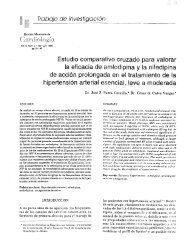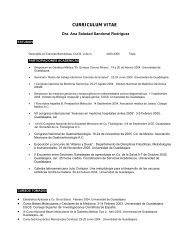Desigualdad Social y Equidad en Salud: Perspectivas Internacionales
Desigualdad Social y Equidad en Salud: Perspectivas Internacionales
Desigualdad Social y Equidad en Salud: Perspectivas Internacionales
- No tags were found...
Create successful ePaper yourself
Turn your PDF publications into a flip-book with our unique Google optimized e-Paper software.
Dec<strong>en</strong>tralization in Mexico can also be described as de-conc<strong>en</strong>tration, but witha differ<strong>en</strong>t system from that of Costa Rica. Mexico’s system is composed of threeprincipal subsystems: (1) a number of Bismark-type social security institutes thatprovide health insurance for the formally employed and their families; (2) Ministryof Health’s services and limited services from nongovernm<strong>en</strong>tal organizations forthe uninsured population; and (3) a large private sector that is almost <strong>en</strong>tirely financedout of pocket (Barraza-Llor<strong>en</strong>s, Bertozzi et al. 2002). In Mexico, the publicsector and social security (including the military services) are responsible for morethan 85% of the hospital beds. (FLEURY 2000). There is a mixed autonomy of resourcesin dec<strong>en</strong>tralized institutions with some c<strong>en</strong>tral resources and some local ones(Arredondo and Parada 2000). There, the dominant elem<strong>en</strong>t of the reform was thecreation of a single state system of health for the uninsured, which <strong>en</strong>tailed transferof responsibility for uninsured populations from the Mexican institute for social security(IMSS) and the State Coordinated Health Services of the Ministry to new <strong>en</strong>titiesunder state authority. The case of Mexico has be<strong>en</strong> qualified as an incompleteor non-existing dec<strong>en</strong>tralization in which the states did not gain a significant levelof control over ev<strong>en</strong> a single aspect of the system, and most of the few new powersthey gained have slowly be<strong>en</strong> tak<strong>en</strong> away from them (Gershberg and Jacobs 1998).Privatization has also be<strong>en</strong> limited. In 1996, Mexico implem<strong>en</strong>ted a package of reformsthat <strong>en</strong>couraged dec<strong>en</strong>tralization, increasing compet<strong>en</strong>cy of private institutionto the IMSS by establishing a market-driv<strong>en</strong> system for those who are covered byhealth insurance through mandatory social security or paym<strong>en</strong>t and a dec<strong>en</strong>tralizedsystem of public minimum services for the poor (Laurell 2001). These changes pointare similar to the type of reform done by Chile and Colombia.The differ<strong>en</strong>ces betwe<strong>en</strong> Mexico and Costa Rica reflect just part of the varietycategorized as de-conc<strong>en</strong>tration, which adopts other forms in other countries. Brazil,for example, is a special case of the dec<strong>en</strong>tralization process in the region. There, theformulation of the reform process was tied to the democratic transition and is an attemptto consolidate a unique, public, universal and dec<strong>en</strong>tralized system of health,based on the idea of health as a citiz<strong>en</strong>’s right guaranteed by the state, appar<strong>en</strong>tly inan opposite route to world-wide dynamics (Almeida 2002). The system is organizedat the federal, state/provincial/regional, and municipal levels. The federal level is legallyresponsible for formulating and implem<strong>en</strong>ting national health policy. It is alsoin charge of system planning, assessm<strong>en</strong>t, and control, as well as resource allocation.Functions at the state level involve service coordination, distribution of financialresources, and decisions related to complex specialized technological interv<strong>en</strong>tions.The municipalities are responsible for handling the delivery of goods and services involvedin health promotion, prev<strong>en</strong>tative care, health care, and rehabilitation. Fundsare allocated to each state according to AIH (authorization for hospital admission)billing, always respecting the corresponding quantitative and financial ceilings. (Almeida,Travassos et al. 2000). The system is composed of three main sub-sectors:14 Dec<strong>en</strong>tralization And Equity
















